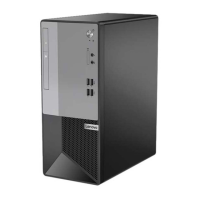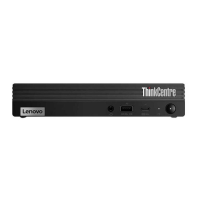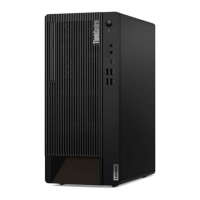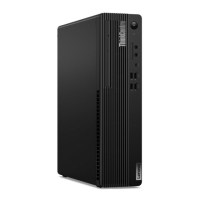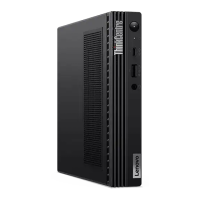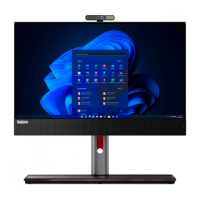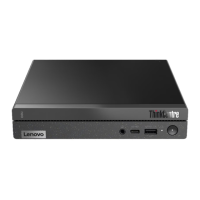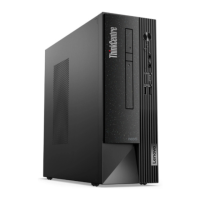Do you have a question about the Lenovo V50t Gen 2 and is the answer not in the manual?
Identifies and illustrates the front panel components of the computer.
Identifies and illustrates the rear panel connectors and slots of the computer.
Details the physical dimensions, hardware, power, and I/O specifications of the computer.
Describes the different USB connectors, their types, and data transfer rates.
Explains how to connect to wired Ethernet and wireless Wi-Fi networks.
Guides on connecting projectors or monitors for presentations or workspace expansion.
Provides instructions on using a smart cable clip for cable management.
Introduces the Vantage app for system maintenance, updates, and personalized support.
Explains how to adjust power plan settings for ENERGY STAR compliant computers.
Describes methods for sharing files using Bluetooth or media cards.
Guides on connecting Bluetooth devices like keyboards, mice, or speakers.
Details methods for physically securing the computer using locks.
Outlines secure login methods using passwords or facial recognition.
Explains setting various passwords within the UEFI BIOS for enhanced security.
Discusses using software like firewalls and antivirus for system protection.
Provides a basic definition and function of UEFI BIOS.
Describes the procedure to access the computer's BIOS setup.
Explains keyboard keys and methods for navigating the BIOS interface.
Details how to change the display language within the UEFI BIOS settings.
Guides on how to set the system date and time within the BIOS.
Explains how to permanently set or temporarily select boot devices.
Describes how to enable/disable alerts for hardware configuration changes.
Details how to configure automatic computer startup from BIOS.
Explains enabling/disabling computer wake-up using keyboard shortcuts.
Covers enabling eco-mode to reduce power consumption in off/sleep states.
Allows adjustment of acoustic and thermal performance via performance modes.
Provides guidance on modifying BIOS settings for OS installation.
Explains methods for downloading and installing BIOS updates.
Provides steps to recover the system after a failed BIOS update.
Details the process to clear the CMOS settings for a BIOS reset.
Outlines essential checks and steps before troubleshooting computer issues.
Guides users on finding solutions for specific computer problem symptoms.
Addresses issues related to the computer failing to start up or boot.
Helps resolve issues related to no sound or incorrect sound output.
Provides solutions for Wi-Fi, Ethernet, and Bluetooth connectivity issues.
Offers solutions for issues like fragmented files or insufficient storage/memory.
Addresses issues where storage drives are not detected or accessible.
Helps resolve problems with optical drives and media not working correctly.
Provides solutions for accessing or using serial connectors.
Offers guidance on troubleshooting issues with USB devices.
Provides solutions for programs not functioning as expected.
Explains how to use diagnostic tools to test hardware and system settings.
Links to specific diagnostic tools provided by Lenovo.
Guides on using the Vantage app for problem diagnosis and hardware scans.
Introduces system recovery options for Windows 10.
Describes using System Restore to revert the system to a previous state.
Guides on recovering personal files using backup tools like File History.
Explains the process of resetting the PC, with options to keep or remove files.
Details accessing advanced startup options for system recovery.
Describes the automatic recovery environment that launches after failed boot attempts.
Guides on creating and using a USB drive for system recovery.
Explains how to download and install the latest drivers for system components.
Lists Customer Replaceable Units (CRUs) that can be upgraded or replaced.
Provides general instructions for removing and replacing computer components.
Details the procedure for removing the computer's outer cover.
Explains the steps to remove the front bezel of the computer.
Guides on how to remove and replace the optical drive.
Provides instructions for removing the drive bay assembly.
Details the process for removing and replacing the internal hard disk drive.
Explains how to remove and install memory modules (RAM).
Guides on locating and replacing the coin-cell battery.
Provides instructions for removing and installing PCI Express cards.
Details the procedure for removing and replacing the M.2 solid-state drive.
Explains how to safely remove and replace the power supply unit.
Lists various resources for troubleshooting and obtaining information.
Provides instructions and information needed before contacting Lenovo support.
Information on Lenovo's commitment to accessibility features.
Guidelines for optimizing workplace setup and posture for comfort.
Lists product names and machine types for certification.
Details FCC compliance statements for the device.
Specifies the recommended temperature, humidity, and altitude ranges for operation and storage.
Contains legal notices, disclaimers, and warranty information.
Lists registered trademarks and intellectual property of Lenovo and other companies.
| Operating System | Windows 10 Pro |
|---|---|
| Optical Drive | Optional DVD-RW |
| Chipset | Intel B460 |
| Graphics | Integrated Intel UHD Graphics or optional NVIDIA GeForce/AMD Radeon |
| Ports | USB 3.2 Gen 1, USB 2.0, HDMI, DisplayPort, VGA, Ethernet, Audio Jack |
| Weight | Starting at 6 kg |
| Connectivity | Ethernet |
| Front Ports | USB 3.2, USB 2.0, audio ports |
| Rear Ports | USB 3.2, USB 2.0, HDMI, DisplayPort, VGA, Ethernet |
| Power Supply | 180W |
| Wireless | Optional Wi-Fi 802.11ac |
| Dimensions | 145mm x 278mm x 360mm (5.7" x 10.9" x 14.2") |
